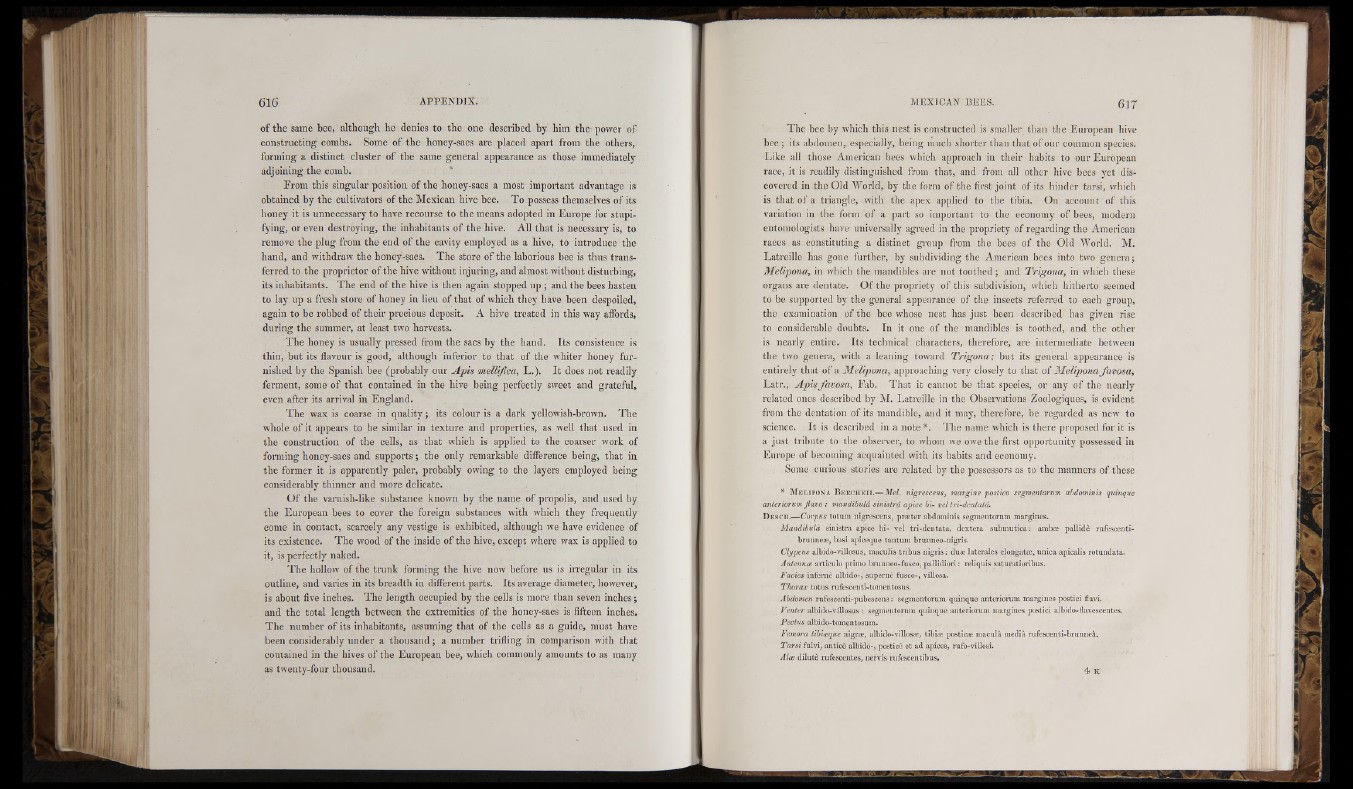
r i i
il «!
Iii H
Ü .it
1^1]!')
of the same bee, although he denies to the one described by him the power of
constructing combs. Some of the honey-sacs are idaced apart from the others,
forming a distinct cluster of the same general appearance as those immediately
adjoining the comb.
From this singular position of the honey-sacs a most important advantage is
obtained by tbe cultivators of the Mexican hive bee. To possess themselves of its
honey it is unnecessary to have recourse to the means adopted in Europe for stupi-
fying, or even destroying, the inhabitants of the hive. All that is necessary is, to
remove the plug from the end of the cavity employed as a hive, to introduce the
hand, and withdraw the honey-sacs. The store of the laborious bee is thus transferred
to the proprietor of the hive without injuring, and almost without disturbing,
its inhabitants. The end of the hive is then again stopped up ; and the bees hasten
to lay up a fresh store of honey in lieu of that of which tliey have been despoiled,
again to be robbed of their precious deposit. A hive treated in this way affords,
during the summer, at least two harvests.
The honey is usually pressed from the sacs by the hand. Its consistence is
thin, but its flavour is good, although inferior to that of the whiter honey furnished
by the Spanish bee (probably our Apis mellifica, L.). It does not readily
ferment, some of that contained in the hive being perfectly sweet and grateful,
even after its arrival in England.
The wax is coarse in quality; its colour is a dark yellowish-brown. The
whole of it appears to be similar in texture and properties, as well that used in
the construction of the cells, as that which is applied to the coarser work of
fonning honey-sacs and supports; the only remarkable difference being, that in
the former it is apparently paler, probably owing to the layers employed being
considerably thinner and more delicate.
Of the varnish-like substance known by the name of propolis, and used by
tbe European bees to cover the foreign substances with which they frequently
come in contact, scarcely any vestige is exhibited, although we have evidence of
its existence. The wood of the inside of the hive, except where wax is applied to
it, is perfectly naked.
The hollow of the trunk forming the hive now before us is irregular in its
outline, and varies in its breadth in different parts. Its average diameter, however,
is about five inches. The length occupied by the cells is more than seven inches;
and the total length between the extremities of the honey-sacs is fifteen inches.
The number of its inhabitants, assuming that of the cells as a guide, must have
been considerably under a thousand; a number trifling in comparison with that
contained in the hives of the European bee, wbich commonly amounts to as many
as twenty-four thousand.
The bee by which this nest is constructed is smaller than the European hive
bee ; its abdomen, especially, being much shorter than that of our common species.
Like all those American bees which approach in their habits to our European
race, it is readily distinguished from that, and from all other hive bees yet discovered
in the Old World, by the form ofthe first joint of its hinder tarsi, which
is that of a triangle, with the apex applied to the tibia. On account of this
variation in the form of a part so important to the economy of bees, modern
entomologists have universally agreed in the propriety of regarding the American
races as constituting a distinct group from the bees of the Old World. M.
Latreille has gone further, by subdividing the American bees into two genera;
Melipona, in which the mandibles are not toothed; and Trígona, in which these
organs are dentate. Ofthe propriety of this subdivision, which hitherto seemed
to be supported by the general appearance of the insects referred to each group,
the examination of the bee whose nest has just been described has given rise
to considerable doubts. In it one of the mandibles is toothed, and the other
is nearly entire. Its technical characters, therefore, are intermediate between
the two genera, with a leaning toward Trígona; but its general appearance is
entirely that of a Melipona, approaching very closely to that of Melipona favosa,
Latr., Apis favosa, Fab. That it cannot be that species, or any of the nearly
related ones described by M. Latreille in the Observations Zoologiques, is evident
fi-om the dentation of its mandible, and it may, therefore, be regarded as new to
science. It is described in a note *. The name which is there proposed for it is
a just tribute to the observer, to whom we owe the first opportunity possessed in
Europe of becoming acquainted with its habits and economy.
Some curious stories are related by the possessors as to the manners of these
* Melipona Bee c h e ii .—M e l. nigrcscens, margine poslico segmenioruin abdominis quinqué
anleriorum jia v o : mandibiild s in is lrd apice hi- vel tri-dcniald.
Descr.—Corpus totum nigrcscens, pra'ter abdominis segmeutorum margines.
M a ndíbula sinistra apico bi- vel tri-dentata, dextera submutica: ambte pallide rufescenti-
bninnea;, basi apicequc tantum brunneo-nigris.
Clypeus albido-villosus, maculis trib u s n ig r is : du£E laterales elongatae, unica apicalis rotuuda ta .
AntenncB articulo primo brunneo-fusco, pallidiori: reliqiiis saturatioribus.
Fa c ie s inferno albido-, supernó fusco-, villosa.
T h o ra x totus rufcscenti-tomcntosus.
Abdomen rufescenti-pubescens; segmentonim quinqué anteriorum margines postici flavi.
Vente r albido-villosus: segmeutorum quinqué anteriorum margines postici albido-tiavescentes.
P e ch is albido-tomcntosum.
Femora libiicqnc nigra?, albido-villosa?, tibia? postica? macula media rufcscenti-brunneá.
T a r s i fulvi, antice albido-, posticu et ad apices, rufo-villosi.
Alee dilute rufcsceiites, nervis rufcsccntibus,